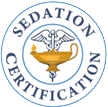Joint Commission is an independent, not-for-profit organization, The Joint Commission accredits and certifies more than 15,000 health care organizations and programs in the United States. Joint Commission accreditation and certification is recognized nationwide as a symbol of quality that reflects an organization’s commitment to meeting certain performance standards
Joint Commission Rationale for PC. 13. 20
Because the response to procedures is not always predictable and sedation to anesthesia is a continuum, it is not always possible to predict how an individual patient will respond. Therefore, qualified individuals are trained and professional standards and techniques to manage patients in the case of a potentially harmful event.
Elements of performance for PC. 13. 20
1. Sufficient numbers of qualified staff are available to evaluate the patient, perform the procedure, monitor and recover the patient.
2. Individuals administering moderate or deep sedation and anesthesia are qualified and have the appropriate credentials to manage patients at what ever level of sedation or anesthesia is achieved, either intentionally or unintentionally.
3. A registered nurse supervises preoperative nursing care.
4. Appropriate equipment to monitor the patient’s physiologic status is available.
5. Appropriate equipment to administer intravenous fluids and drugs, including blood and blood components, is available as needed.
6. Resuscitation capabilities are available. Before operative and other procedures or the administration of moderate or deep sedation or anesthesia.
7. Patient acuity accessed to plan for the appropriate level of post procedure care
8. Pre-procedural education, treatments, and services are provided according to the plan for care, treatment, and services.
9. The side, procedure, and patient are accurate accurately identified and clearly communicated, using active communication techniques, during the final verification process, such as “timeout,” prior to the start of any surgical invasive procedure.
10. A pre sedation or anesthesia assessment is conducted.
11. Before sedating or anesthetizing the patient, and LIP with appropriate clinical privileges plans or concurs with the planned anesthesia.
12. The patient is re-evaluated immediately before moderate or deep sedation and before anesthesia induction.
A 2000 Revisions to Anesthesia Care Standards in the Comprehensive Accreditation Manual for Hospitals states that:
“Qualified individuals” conducting sedation must possess education, training and experience in:
1. Evaluating patients prior to moderate or deep sedation
2. Rescuing patients who slip into a “deeper than desired” level of sedation or anesthesia.
3. Managing a compromised airway during a procedure.
4. Handling a compromised cardiovascular system during a procedure.
